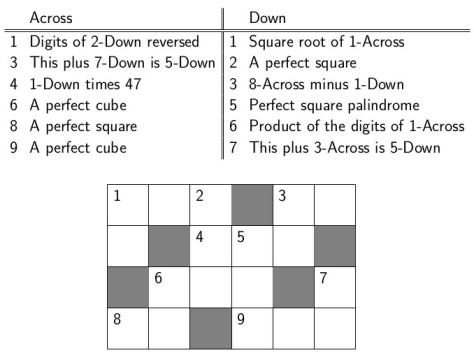This week, we’ll look at one of my favorite types of puzzles — CrossNumber Puzzles. These are like crossword puzzles, except that the clues describe numbers instead of words. The only rule is that no entry in a CrossNumber Puzzle can start with a “0.” You can try this one — but don’t worry if you get stuck. We’ll look at different ways you can go about solving it in just a moment.
How would you go about solving this puzzle? Try to look for the clues which give you the most information. For example, look at 1 Across and 3 Down. Now 1 Across is the cube of a two digit number, and its third digit is actually the first digit of the cube root. So we might want to print out a chart of all four-digit cubes of two-digit numbers:
| 10 | 1000 | 16 | 4096 | |
| 11 | 1331 | 17 | 4913 | |
| 12 | 1728 | 18 | 5832 | |
| 13 | 2197 | 19 | 6859 | |
| 14 | 2744 | 20 | 8000 | |
| 15 | 3375 | 21 | 9261 |
You can see that the only possibility is that 1 Across is 4913 and 3 Down is 17.
Looking at 5 Across doesn’t help much, since there are too many possibilities.
But looking at 5 Down is a good next choice. Note that 9 Across has to start with 1 or 3 in order to fit four odd digits in the grid, but no perfect squares end in 3, and so no perfect fourth powers end in 3, either. This means that 9 Across has to start with 1 so that 5 Down ends in 1. To help figure out 5 Down, below is a list of four-digit fourth powers:
| 6 | 1296 | 8 | 4096 | |
| 7 | 2401 | 9 | 6561 |
So 5 Down must be either 2401 or 6561. If it were 2401, then 6 Across would begin with a “0,” so that leaves 6561 as the only option for 5 Down.
I’ll leave it to you to complete the puzzle. I won’t post a solution so that you’re not tempted to peek — but if you add 2 Down and 6 Across when you’re done, you’ll get 157,991.
How can you make your own CrossNumber puzzle? Start by making a grid, and shade in some of the squares. Usually the pattern of shaded squares is symmetric, but it doesn’t have to be. Fill in some of the entries with numbers which have specific properties, like being a perfect square or cube. Or perhaps make one of the entries the product or sum of two others. The only limit is your imagination! It might help to continue reading below, since then you could print different charts and look at the numbers for something interesting. (And get another puzzle to solve, too.)
To create interesting CrossNumber puzzles requires some imagination. And of course, a computer couldn’t hurt! You might want to print out squares or cubes, or more complex arrays of numbers — then look for patterns or digits in common.
It’s not hard to do this in Python. Click on the following link to see the number generating routines used in today’s post. These are simple patterns — you’ll need to learn more about programming if you want to investigate more complicated relationships. But the online help for Python syntax isn’t too bad, so you can experiment freely.
I’ve included one additional example in the worksheet. In creating CrossNumber puzzles, you might want to look at a particular digit of a number. So if you wanted the third digit from the right, you could use integer division in Python: 12,345 // 100 is just 123. Then to get the 3, you use modular arithmetic: 123 % 10. This will automatically result in a third digit of 0 if the number is less than 100.
This routine can be adapted to find any digit of a number (from the right), as is also done in the worksheet. You can also try writing routines which extract digits from the left, or middle digits, or….
Just for fun, here’s another CrossNumber puzzle for you to solve.
If you’d like a printer-friendly version of this puzzle for personal or classroom use, you may download it here: Day003Puzzle2


Give me a hint about 5 across (6,9,_,7,_)
LikeLike
Because 5A has consecutive digits in some order, you know what numbers go in the blanks. To see which order, see 4D. Look at four-digit squares starting with 3, and see what the possibilities are for the second digit.
LikeLike